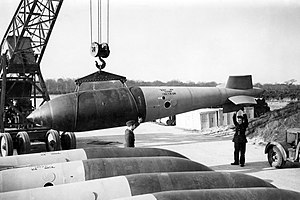| Grand Slam | |
|---|---|
 A Grand Slam bomb being handled at RAF Woodhall Spa in Lincolnshire | |
| Type | Earthquake bomb |
| Place of origin | United Kingdom |
| Service history | |
| In service | 1945 |
| Used by | Royal Air Force |
| Wars | Second World War |
| Production history | |
| Designer | Barnes Wallis |
| Designed | 1943 |
| Manufacturer | Vickers, Sheffield Clyde Alloy/Steel Company of Scotland, Blochairn, Glasgow |
| Produced | 1944–1945 |
| No. built | 42 used, 99 built by Clyde Alloy and the A. O. Smith Corporation of America[1]
|
| Variants | M110 (T-14) 22,000-lb GP Bomb (United States)[3] |
| Specifications | |
| Mass | 22,000 lb (10,000 kg) |
| Length | 26 ft 6 in (8.08 m) |
| length | Tail 13 ft 6 in (4.11 m) |
| Diameter | 3 ft 10 in (1.17 m) |
| Filling | Torpex D1 |
| Filling weight | 9,500 lb (4,300 kg) |
Detonation mechanism | penetration: earth 40 m (130 ft); concrete 6 m (20 ft)[4] |
| Blast yield | 6.5 long tons (6.6 t) TNT equivalent |
The Bomb, Medium Capacity, 22,000 lb (Grand Slam) was a 22,000 lb (10,000 kg) earthquake bomb used by RAF Bomber Command against German targets towards the end of the Second World War. The bomb was originally called Tallboy Large until the term Tallboy got into the press and the code name was replaced by "Grand Slam". The bomb was similar to a large version of the Tallboy bomb but a new design and closer to the size that its inventor, Barnes Wallis, had envisaged when he developed the idea of an earthquake bomb. It was the largest and most powerful conventional aerial bomb used by either side during the war.[5]
Medium Capacity (M.C.) bombs were designed to remedy the shortcomings of General Purpose (G.P.) bombs, with a greater blast and casings which were robust enough to confer a considerable capacity to penetrate, especially the Tallboy and Grand Slam. The Grand Slam case was made of a chrome-molybdenum alloy steel and had a charge-to-weight ratio of over 43 per cent.
Standard Avro Lancaster bombers could not carry the bomb; Avro built 32 Lancaster B.Mk 1 (Special)s with more powerful Merlin engine variants, a stronger undercarriage, without bomb bay doors and minus many items to save weight. When airborne with the Grand Slam, a Special could barely manoeuvre, and pilots were advised to refrain from minor adjustments of the flying controls, allowing the aircraft to wallow. A Lancaster which returned with its bomb was not permitted to land at RAF Woodhall Spa, the 617 Squadron base; it had to use the longer runway at RAF Carnaby.
From 14 March to 19 April 1945, 42 Grand Slams were dropped on Germany. When landing on reinforced concrete, the bombs tended to break up on impact or explode prematurely. The bombs had been designed to land in soft ground, penetrate deeply and then explode, creating a camouflet, causing the structure above to subside. Grand Slams and Tallboys were capable of causing damage that smaller bombs could not, accelerating the collapse of German resistance and avoiding mass civilian casualties. Grand Slams were the most effective bombs used by the Allies until the advent of atomic weapons later that year. After the war, the Royal Air Force and United States Army Air Forces used Grand Slams and other bombs for research.
- ^ Flower 2004, appendix 4.
- ^ Webster & Frankland 1994, p. 203.
- ^ Ruby 1946, pp. 11–12.
- ^ Flight 1946.
- ^ Gnam, Carl (26 December 2018). "'Mother of All Bombs' (MOAB) Blast Radius vs. the Largest Bombs of WWII". Warfare History Network. Retrieved 2 October 2023.